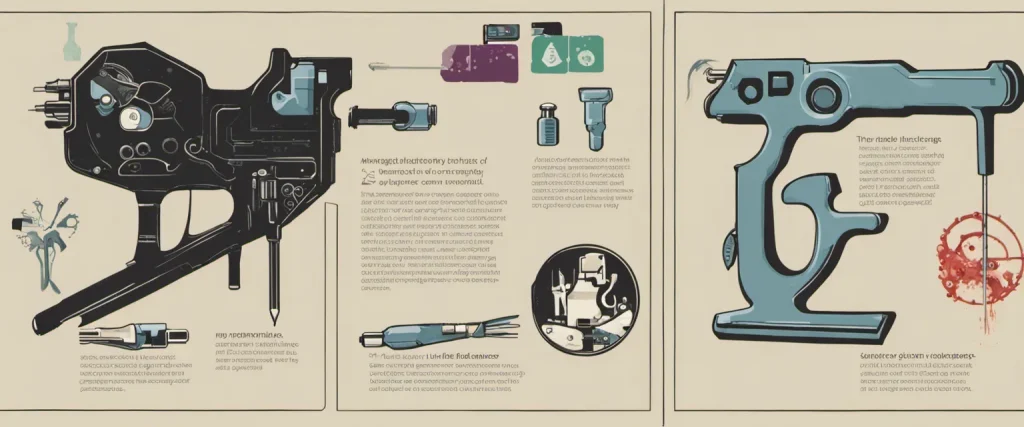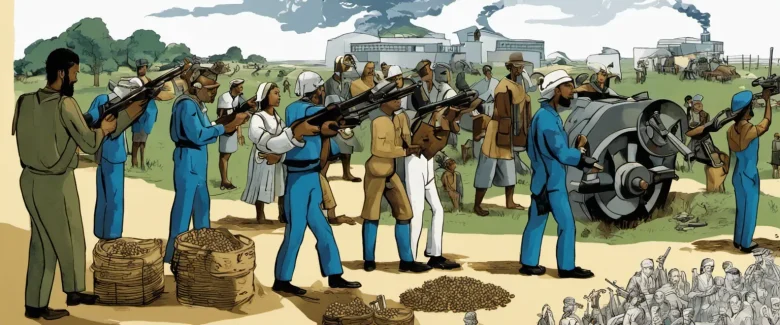In Jared Diamond‘s book “Guns, Germs, and Steel,” the author embarks on a profound exploration of human history, questioning why certain civilizations have succeeded while others have faltered. As a renowned biologist, geographer, and historian, Diamond brings a unique multidisciplinary perspective to his analysis. Through this seminal work, he seeks to decipher the complex interplay of geographical factors, biological developments, and cultural evolution that have shaped the course of human civilizations across millennia. By uncovering the critical role of guns, germs, and steel in determining human fate, Diamond challenges conventional narratives and offers a fresh lens through which to understand our shared past.
Chapter 1: Introduction
Chapter 1 of “Guns, Germs, and Steel” by Jared Diamond sets the stage for the book’s exploration of why certain societies developed at a faster pace than others. Diamond aims to identify the underlying factors that allowed some societies, particularly those in Europe, to gain an advantage in terms of power, technology, and wealth. He begins his analysis by addressing the idea of cultural differences as the main reason for these disparities.
Exploring the example of conquistadors from Spain successfully subjugating the Incas in Peru, Diamond argues against the notion that European superiority was primarily due to inherent racial or intellectual disparities. Instead, he proposes that environmental factors played a crucial role. Diamond argues that certain regions of the world had an advantage in terms of domesticable plants and animals, leading to more stable agricultural practices and the development of complex societies. These regions, particularly the Fertile Crescent in the Middle East, eventually saw the rise of early civilizations.
Diamond emphasizes the significance of domesticated animals in the process of human advancement. In areas where native animals could be domesticated, such as Eurasia, humans were able to use their labor for transportation, agriculture, and warfare, setting the stage for societal growth. Conversely, the lack of large, domesticable animals in the Americas hindered indigenous societies from making similar advancements.
The author posits that geographical factors, such as the availability of suitable crops and animals, influenced the rate at which societies developed. He also introduces the concept of “continental axes”: the east-west orientation of continents played a crucial role in sharing agricultural and technological advancements. This allowed for the diffusion of ideas across societies, further contributing to the different rates of development observed throughout history.
Overall, Chapter 1 lays the foundation for Diamond’s argument that geography and environmental factors, rather than intellectual or racial superiority, played a major role in shaping the fates of different societies. These ideas set the stage for his exploration of how guns, germs, and steel influenced the course of human history.
Chapter 2: The Out of Africa Theory
Chapter 2 of Jared Diamond’s book, “Guns, Germs, and Steel,” focuses on the Out of Africa theory, which explains how and why Homo sapiens evolved in Africa and then dispersed to other parts of the world.
Diamond begins by highlighting the dominant view among archaeologists and anthropologists that all humans share a common ancestry in Africa. This view is supported by genetic evidence and the fact that the oldest human fossils have been found in Africa. Diamond then discusses the comparative advantage Africa had in supporting human life due to its fertile land, diverse flora and fauna, and mild climate. These factors allowed ancient Africans to develop complex foraging and hunting practices, leading to the evolution of Homo sapiens.
Next, the book explores the different routes taken by humans to leave Africa and populate other continents. Diamond describes how humans migrated to the Middle East, Europe, and Asia, primarily driven by environmental factors such as shifts in climate, the availability of resources, and the ability to adapt. He also emphasizes how the process of migration and settlement led to the development of different human populations, each adapted to its respective environment.
Diamond addresses the question of why humans from different continents developed at different speeds and in various ways. He argues that differences in domesticable plant and animal species influenced the rate of development. Eurasia, in particular, had an advantage due to its high number of potential domesticates like wheat, barley, cows, pigs, and horses, which facilitated the rise of agriculture and the subsequent development of complex societies.
In conclusion, Chapter 2 provides a comprehensive overview of the Out of Africa theory, explaining the origins and dispersal of Homo sapiens and how environmental factors influenced the development of different human populations across the globe.
Chapter 3: The Role of Agriculture
Chapter 3: The Role of Agriculture in the book “Guns, Germs, and Steel” by Jared Diamond explores the crucial transition from hunting and gathering to agriculture as a means of food production. Diamond argues that agriculture played a pivotal role in the development and domination of some societies over others.
The chapter begins by explaining how agriculture emerged independently in various parts of the world around 11,000 years ago. It discusses how the cultivation of crops and domestication of animals allowed for a more stable and reliable food supply. This surplus of food led to the growth of settled communities and the division of labor, with some individuals specializing in non-food-producing activities such as toolmaking or governing.
Diamond highlights the advantages of agriculture over hunting and gathering. Whereas hunter-gatherer societies needed to constantly search for food, agricultural societies could create permanent settlements and focus on expanding their populations. This, in turn, allowed for the development of larger societies with more complex social and political structures.
The chapter also explores the consequences of agriculture. While it brought many benefits, it also led to challenges such as increased risk of disease transmission due to larger population densities and close contact with domesticated animals. Diamond argues that this resulted in the development of immunities to diseases in certain societies, giving them an advantage over others later on in history.
Overall, the chapter emphasizes the profound impact that agriculture had on human history. It enabled the rise of sedentary civilizations and paved the way for technological advancements, social complexity, and ultimately, the emergence of societies with guns, germs, and steel.
Chapter 4: The Rise of Complex Societies

Chapter 4 explores the factors that contributed to the development of complex societies. Diamond argues that geographic and environmental factors played a significant role in shaping the course of history.
One key factor highlighted in this chapter is how favorable environments influenced the rise of agriculture. Societies that could successfully domesticate plants and animals enjoyed surplus food production, leading to sedentary lifestyles and the establishment of permanent settlements. These settlements, in turn, allowed for the growth of larger populations and the development of complex social and economic systems.
Another factor discussed is the impact of continental axes that facilitated the spread of crops, livestock, and knowledge. Diamond highlights the geographical connectivity of Eurasia, which allowed for the diffusion of agriculture and technologies from one area to another. In contrast, the Americas and Africa had major geographical barriers, such as the Andes Mountains and the Sahara Desert, respectively, hindering the spread of these crucial aspects of civilization.
Moreover, Diamond emphasizes the role of technological advancements like writing and metalworking in enabling the rise of complex societies. These innovations allowed for the accumulation and transfer of knowledge, the development of specialized occupations, and the creation of political structures.
In summary, Chapter 4 of “Guns, Germs, and Steel” argues that the rise of complex societies was primarily influenced by favorable environments that supported agriculture, the geographic connectivity of continents, and technological advancements. These factors, combined with surplus food production, settled lifestyles, and the exchange of knowledge, led to the development of complex social and economic systems.
Chapter 5: The East-West Axis
Chapter 5 explores the significance of the east-west orientation of continents in history, particularly in relation to the spread of food production and domestication. Jared Diamond explains how the shape and orientation of continents influenced the diffusion of plants, animals, people, and technologies.
Diamond argues that the east-west axis is particularly advantageous for the spread of agriculture because similar latitudes share similar climates and day lengths. This enables the rapid spread of crops and domesticated animals, as they can easily adapt to new regions around the same latitude. For instance, Eurasia, stretched across a wide east-west axis, could share crops such as wheat and barley from the Middle East all the way to China.
In contrast, regions that lie on a north-south axis, such as the Americas and Africa, face difficulties in the spread of agriculture due to abrupt climate changes caused by different latitudes. These abrupt climate changes hinder the suitability of crops and animal species from one latitude to another, making it challenging for the diffusion of food production.
Furthermore, Diamond explores how the long east-west axis of Eurasia also played a significant role in the transfer of technologies and ideas. Due to the similar climates and day lengths across the Eurasian continent, it was easier for people to migrate and exchange innovations compared to regions on a north-south axis. This facilitated the spread and accumulation of knowledge and technology in Eurasia.
Overall, Chapter 5 highlights the crucial influence of the east-west axis in the diffusion of food production, domestication, and technological innovations, ultimately contributing to the development and advancement of societies in Eurasia.
Chapter 6: The Power of Germs
Chapter 6 delves into the role of diseases in shaping human history. Jared Diamond argues that the spread of diseases, particularly infectious diseases, played a crucial role in the conquest and colonization of vast territories. He starts by examining the devastating impacts of European diseases, such as smallpox, measles, and influenza, on indigenous populations in the Americas.
Diamond explains that the indigenous people lacked immunity to these new infectious diseases brought by the Europeans, resulting in catastrophic population declines. This demographic collapse created a power vacuum that facilitated European colonization. While diseases had plagued societies throughout history, the difference lay in the development and transmission of infectious diseases due to dense populations and proximity to animals in Eurasia.
The author explores the origins of human diseases, drawing attention to the close proximity between animals and humans in Eurasia, fostering the evolution and transmission of various diseases. The domestication of animals played a crucial role in this process, as close contact with animals allowed for the transmission of diseases from animals to humans. In contrast, regions without a long history of animal domestication, such as the Americas and Australia, lacked the same range and intensity of infectious diseases, leaving their populations vulnerable to devastating epidemics.
Diamond concludes the chapter by highlighting the importance of infectious diseases in determining the course of history. The unintentional spread of diseases by explorers and colonizers resulted in significant advantages for the Eurasian powers, as it crippled the populations and resistance of the native inhabitants, enabling the European conquest of vast territories. Additionally, he emphasizes the critical role of disease transmission, domestication of animals, and the ecology of microorganisms in shaping the fates of societies across different continents.
Chapter 7: Colonization and Conquest
Chapter 7 explores the colonization and conquest of indigenous societies by European powers. Diamond uses this chapter to deconstruct popular myths surrounding European superiority, arguing that the colonial conquest was mainly driven by geographic and ecological factors rather than innate biological superiority or intellectual prowess.
The chapter begins by examining the Spanish conquest of the Inca Empire in Peru. Diamond explains how the Inca Empire, while technologically advanced in some aspects, lacked the same level of military technology as the Spanish conquistadors. The Spanish had horses, firearms, steel weapons, and immune systems adapted to various diseases, giving them a significant advantage during the conflict.
Diamond then moves on to discuss the conquest of the Aztecs in Mexico by Hernán Cortés and his small group of conquistadors. Despite being outnumbered by the Aztecs, the Spanish were victorious due to their superior weapons, armor, and immune systems. However, Diamond emphasizes that the ultimate factor contributing to the Spanish victory was the unintentional introduction of deadly diseases, such as smallpox, which wiped out a significant portion of the Aztec population.
Diamond concludes the chapter by examining other instances of European colonization, such as the British colonization of Australia and the Dutch colonization of South Africa. In each case, he highlights how European powers benefited from their technological advancements and acquired immunities, allowing them to dominate the indigenous populations.
Overall, Chapter 7 of “Guns, Germs, and Steel” argues that European colonial success was primarily shaped by geographic and ecological factors, providing European powers with inherent advantages that helped them conquer indigenous societies. It challenges the traditional narratives that solely attribute European success to innate biological superiority or intellectual achievements.

Chapter 8: The Future of Human History
Chapter 8 explores several factors that will shape the future of human societies. Firstly, Diamond discusses the potential impact of genetic engineering on human evolution. He argues that while genetic engineering holds incredible potential for improving lives, it also raises ethical concerns and the possibility of creating a genetically engineered underclass.
Diamond then examines the influence of culture on population growth. He emphasizes that cultural factors such as the value placed on education and access to contraception, among others, greatly affect population growth rates. He highlights the importance of striking a balance between cultural values that encourage population growth and implementing policies that promote sustainability.
Next, Diamond discusses the potential threats to human survival, including nuclear weapons and climate change. He stresses the need for international cooperation to address these global problems effectively and avoid catastrophic outcomes.
Furthermore, Diamond explores the role of nationalism and the impact of global economic integration. He argues that while nationalism may provide stability and a sense of identity, excessive nationalism can lead to conflicts and hinder cooperation necessary for addressing global challenges. In contrast, economic integration offers opportunities for increased communication, trade, and collaboration.
Lastly, Diamond addresses the issue of societal collapse. Drawing on historical examples, he warns that societies face collapse when their leaders fail to anticipate and manage environmental challenges. However, he also highlights that some societies have successfully overcome challenges through effective decision-making and adapting to new circumstances.
In conclusion, Chapter 8 provides a thought-provoking analysis of potential future scenarios for human societies, urging readers to consider the impact of genetic engineering, cultural factors, global threats, nationalism, economic integration, and the importance of effective leadership in shaping the future of human history.
After Reading
In conclusion, Jared Diamond’s book “Guns, Germs, and Steel” provides a thought-provoking and comprehensive exploration of why certain societies develop faster and become more advanced than others. Diamond’s main arguments revolve around the importance of geographical advantages, the emergence and spread of agriculture, the domestication of animals, and the resulting disparities in technology, political organization, and cultural development. By tracing the origins of inequality from the dawn of human civilization to the modern world, Diamond sheds light on why some countries have thrived while others have struggled, challenging assumptions about inherent intellectual or genetic differences between societies. Ultimately, “Guns, Germs, and Steel” highlights the pivotal role of geography and historical contingency in shaping the destinies of nations.
Book 1: The Tipping Point by Malcolm Gladwell
“The Tipping Point” explores the phenomenon behind the sudden and dramatic changes that occur in society. Malcolm Gladwell delves into the concept of how little things can make a significant impact and cause a ‘tipping point’ in various areas, from marketing to social behavior. This thought-provoking book reveals fascinating insights into human psychology and the factors that influence societal trends.
Book 2: The Art of War by Sun Tzu
“The Art of War” is a timeless classic that offers profound wisdom on strategy and leadership. Written by Sun Tzu, a Chinese military general, this book delves into principles of warfare and their applications to other areas of life. It teaches readers invaluable lessons on adaptability, decision-making, and the importance of understanding one’s enemy. The Art of War serves as an essential guide for navigating challenges and achieving success, both in battle and in daily life.
Book 3: Why the West Rules—for Now by Ian Morris
“Why the West Rules—for Now” takes an alternate approach to understanding global history, contrasting the trajectories of East and West civilizations. Ian Morris explores the reasons behind the West’s current dominance and analyzes various factors, such as geography, culture, and biology, that shaped the course of history. This captivating book challenges conventional thinking and offers fresh perspectives on the rise and fall of civilizations.
Book 4: Sapiens: A Brief History of Humankind by Yuval Noah Harari
In “Sapiens: A Brief History of Humankind,” Yuval Noah Harari presents a compelling narrative that explores the journey of our species from prehistoric times to the modern era. Harari masterfully weaves together history, biology, and anthropology to illuminate the key events and developments that shaped human civilization. This book offers invaluable insights into our own nature as Homo sapiens and raises profound questions about the future of our species.
Book 5: Thinking, Fast and Slow by Daniel Kahneman
“Thinking, Fast and Slow” by Daniel Kahneman provides an eye-opening exploration of the human mind and its decision-making processes. Kahneman, a Nobel laureate in economics, delves into the concepts of System 1 (fast, intuitive thinking) and System 2 (slow, deliberate thinking) and examines how they influence our choices, judgments, and biases. This engaging book will transform the way you think about thought itself, enabling you to make more informed decisions in various aspects of life.



